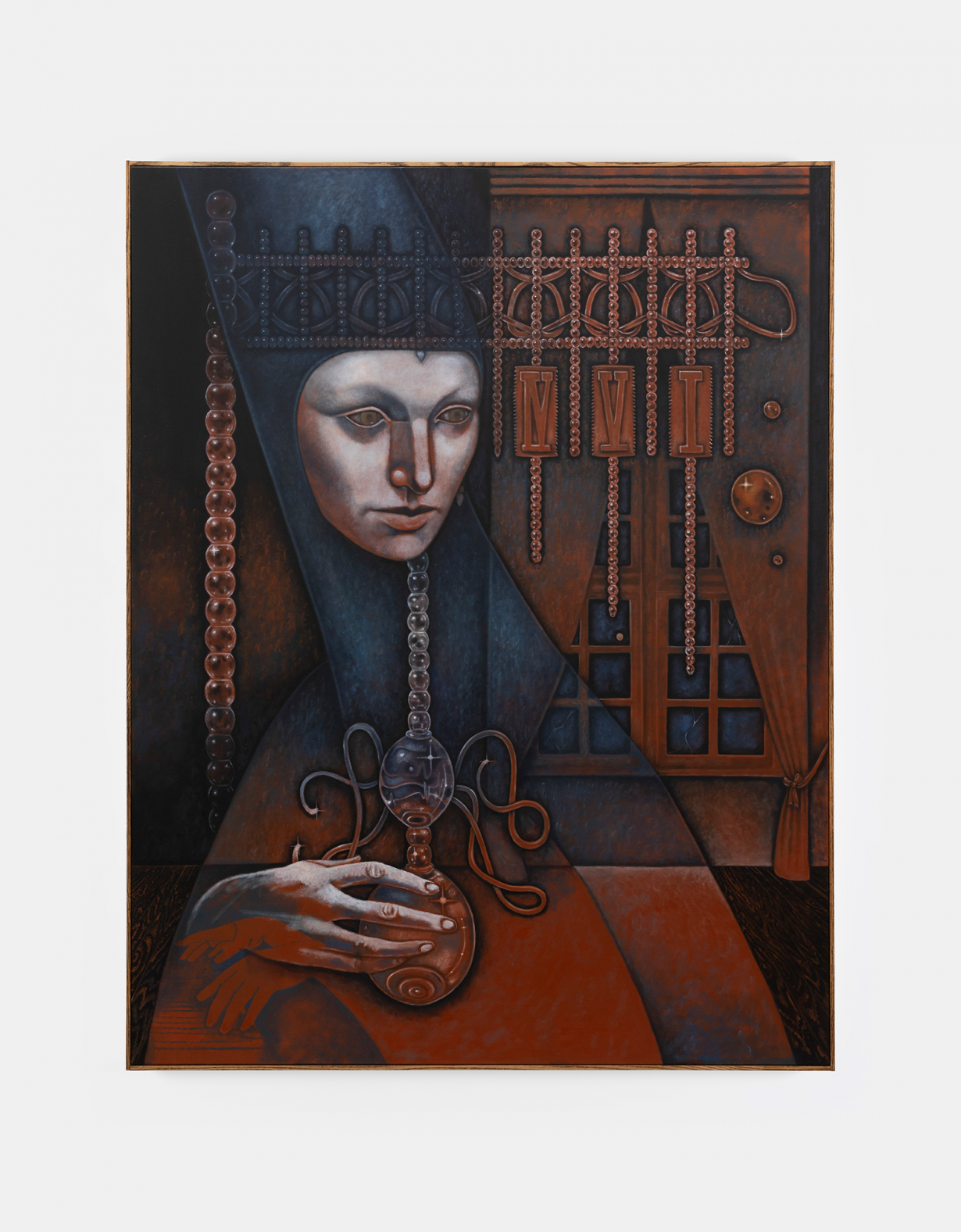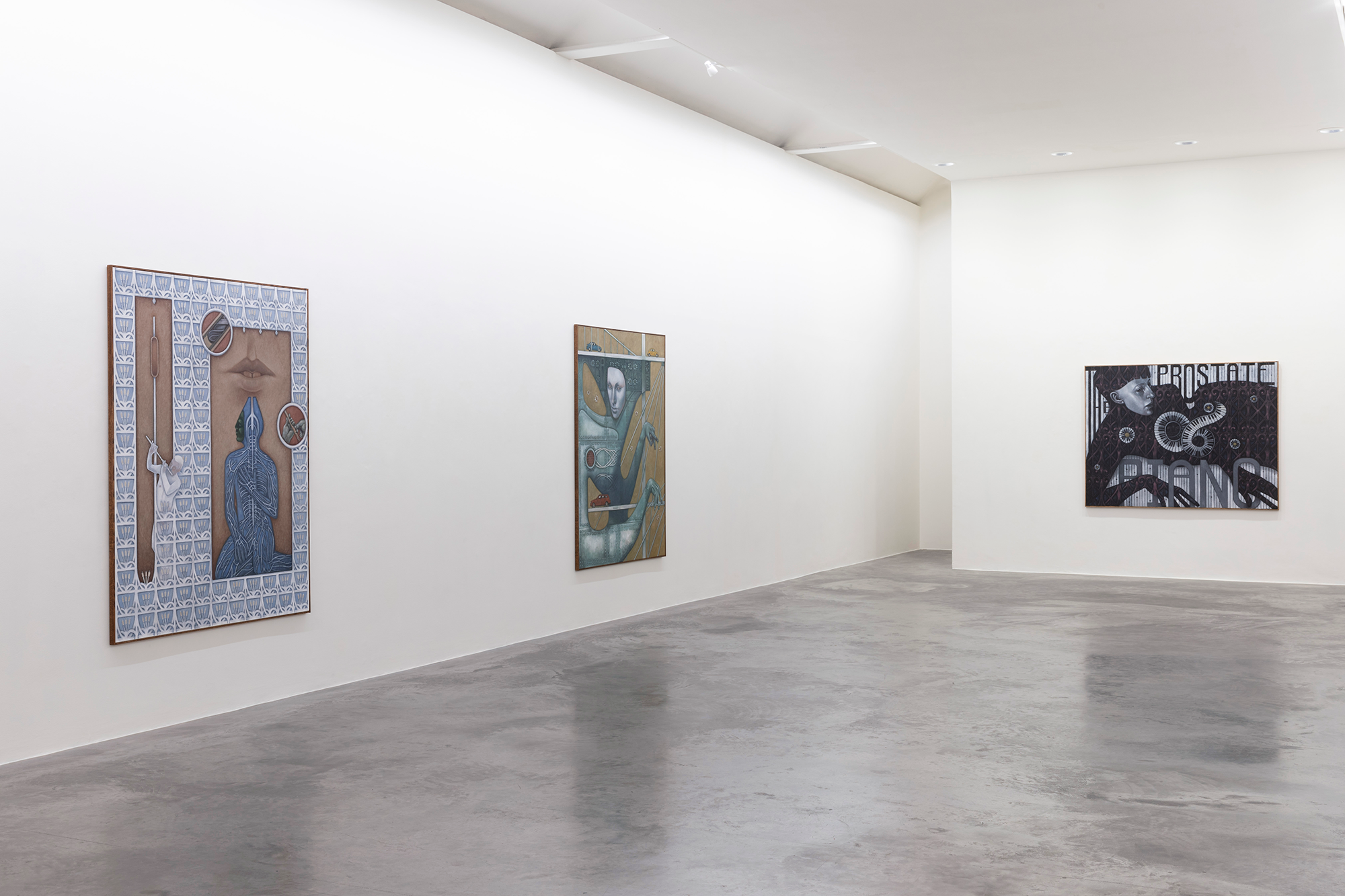In his gothic-surrealistic works, the artist casts his characters not as autonomous artistic agents but as acquiescent, adaptable instruments
Puzzled by the ghostly faces and fragmented bodies in Justin Fitzpatrick’s paintings – figures merged with musical instruments, held within constraining structures – I’m reminded of a moment in Iggy Pop’s 1982 memoir, I Need More. For the Godfather of Punk, life as a performer had required ‘constant exposure to amplifiers and electric guitars’, and the persistent ‘electric hum’ of stage and studio, he believed, had left him with ‘altered body chemistry’. Enduring, even enjoying, these invasive sonic conditions, Iggy chose to explore their physiological effects ‘as if I were a scientist experimenting on myself, like Dr. Jekyll’.
The eight gothic-surrealistic works included in the Dublin-born Fitzpatrick’s A Musical Instrument share something of this fascination with testing and transformation, shaping an imaginative space of minds and bodies ‘altered’ under music’s heady influence. Fitzpatrick’s pictures – aesthetically out-of-time, echoing art deco ornamentation, Arts and Crafts patterning, 1960s psychedelia, with hints of H.R. Giger’s biomechanical visions – conjure ornate, eerie scenarios suggestive of the body’s sensory porosity and sound’s penetrating intensity. Human forms are positioned and partitioned beneath assertive grids or enmeshed within decorative latticing. Caged, haunted, their bodies pinned down or opened up – in compositions sometimes overlaid with strips of musical notation – the characters look to be, in several cases, unusually disposed musicians: played by, instead of playing, their melodies. Fitzpatrick casts them not as autonomous artistic agents but as acquiescent, adaptable instruments of overwhelming, almost supernatural forces.

Informing the eldritch atmosphere of this fantasy world is the 1860 poem by Elizabeth Barrett Browning from which the exhibition takes its title. Published a year before the poet’s death (perhaps aptly, in relation to Fitzpatrick’s themes, she struggled with severe spinal pain throughout her life, taking laudanum from the age of fifteen), ‘A Musical Instrument’ recounts the Greek god Pan fashioning a flute from a river reed: an act framed as an arrogant, wounding assault on nature. Fitzpatrick takes this mythic vignette as a trigger for ambiguous reflections on creativity and destruction, using his highly cultivated style to contemplate deep tensions of aesthetic experience – whether the passionate searching and romanticised suffering of artistic lives, or the concurrence of pain and pleasure at art’s transgressive limits.
In Aeolian harp suspension bridge (all works 2024), the fingers of a colossal godlike musician pluck at vast structural cables: a powerful being, rivet-studded into the architectural form, apparently bound to its fate, constrained by this labour of unearthly artistic creation. A nunlike presence within the gloomy interior setting of The Glass Armonica (Dying at my music) grips a clear goblet, adorned with curling strands. The figure’s form is fading away, as if the music from the device she holds transforms space around it and alters the body chemistry of those who play it. (Identified in the title, the object is an unusual handheld version of a bizarre eighteenth-century invention, said to have driven its most devoted performers to insanity.)
Perhaps what initially bemuses one most about Fitzpatrick’s paintings is also what successfully distinguishes them: the combination of the sinister and the serene, the synthesis of dark subjects with touches of extreme tenderness. (Poster for a Musical (The Prostate Piano), featuring an androgynous figure lounging across the titular instrument, is among the most erotically forthright examples here of the latter tendency.) Up close, there is an exquisite softness to the velvety oil-painted surfaces of each piece. Underlying Fitzpatrick’s esoteric historical references and sometimes portentous subjects, we find an insistently expressed sensitivity. Through an art of poised, posthuman melodrama – where bodies divide, dissolve, become undone – he invites us to immerse ourselves in the complexity and polysemy of human feelings.
Justin Fitzpatrick A Musical Instrument at Kerlin Gallery, Dublin, 25 October – 23 November
